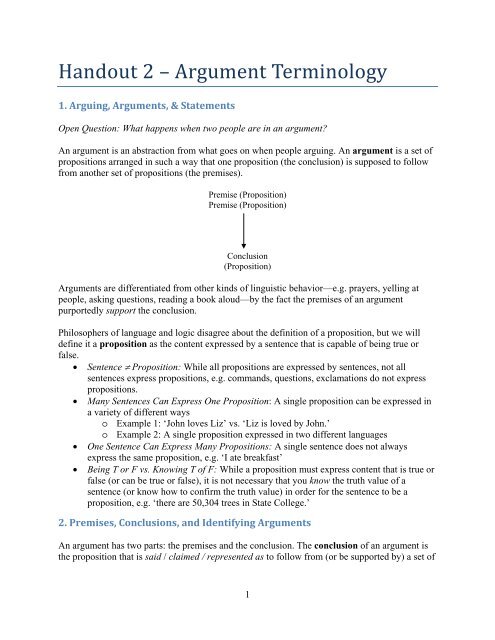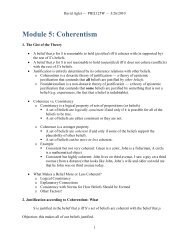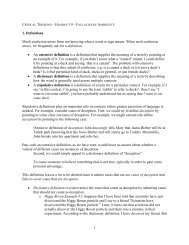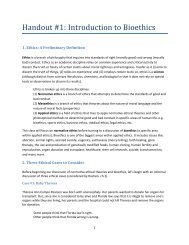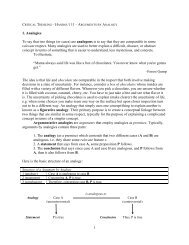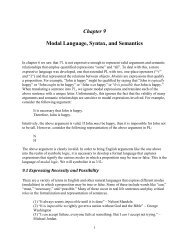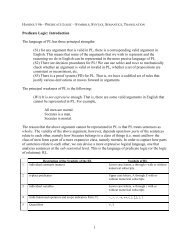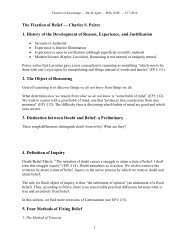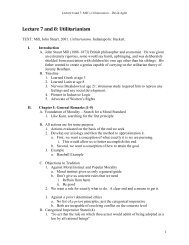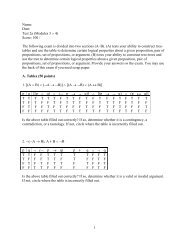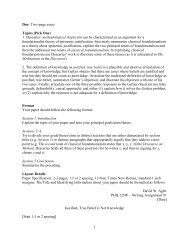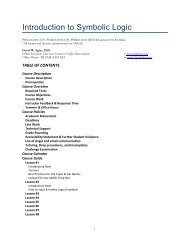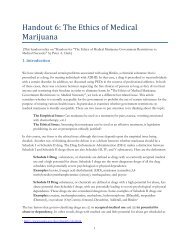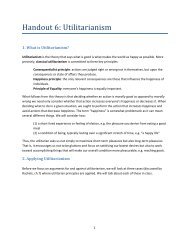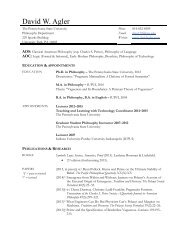Handout 2 â Argument Terminology - David W. Agler
Handout 2 â Argument Terminology - David W. Agler
Handout 2 â Argument Terminology - David W. Agler
Create successful ePaper yourself
Turn your PDF publications into a flip-book with our unique Google optimized e-Paper software.
<strong>Handout</strong> 2 – <strong>Argument</strong> <strong>Terminology</strong><br />
1. Arguing, <strong>Argument</strong>s, & Statements<br />
Open Question: What happens when two people are in an argument?<br />
An argument is an abstraction from what goes on when people arguing. An argument is a set of<br />
propositions arranged in such a way that one proposition (the conclusion) is supposed to follow<br />
from another set of propositions (the premises).<br />
Premise (Proposition)<br />
Premise (Proposition)<br />
Conclusion<br />
(Proposition)<br />
<strong>Argument</strong>s are differentiated from other kinds of linguistic behavior—e.g. prayers, yelling at<br />
people, asking questions, reading a book aloud—by the fact the premises of an argument<br />
purportedly support the conclusion.<br />
Philosophers of language and logic disagree about the definition of a proposition, but we will<br />
define it a proposition as the content expressed by a sentence that is capable of being true or<br />
false.<br />
• Sentence ≠ Proposition: While all propositions are expressed by sentences, not all<br />
sentences express propositions, e.g. commands, questions, exclamations do not express<br />
propositions.<br />
• Many Sentences Can Express One Proposition: A single proposition can be expressed in<br />
a variety of different ways<br />
o Example 1: ‘John loves Liz’ vs. ‘Liz is loved by John.’<br />
o Example 2: A single proposition expressed in two different languages<br />
• One Sentence Can Express Many Propositions: A single sentence does not always<br />
express the same proposition, e.g. ‘I ate breakfast’<br />
• Being T or F vs. Knowing T of F: While a proposition must express content that is true or<br />
false (or can be true or false), it is not necessary that you know the truth value of a<br />
sentence (or know how to confirm the truth value) in order for the sentence to be a<br />
proposition, e.g. ‘there are 50,304 trees in State College.’<br />
2. Premises, Conclusions, and Identifying <strong>Argument</strong>s<br />
An argument has two parts: the premises and the conclusion. The conclusion of an argument is<br />
the proposition that is said / claimed / represented as to follow from (or be supported by) a set of<br />
1
propositions, while the premises of an argument are the propositions (or reasons) that are said to<br />
support (or entail) the conclusion.<br />
One key critical-thinking capacity is the ability to identify arguments from non-arguments. In<br />
some cases, it is easy to identify what is and is not an argument and easy to identify the<br />
premises/conclusion of an argument, but sometimes it is not so easy. Here are some tips to keep<br />
in mind:<br />
Tip #1: <strong>Argument</strong>s tend to have arguments indicators like ‘therefore’, ‘since’, ‘due to the fact<br />
that’, ‘it follows that’, ‘consequently’ which indicate the presence of an argument. Often, these<br />
argument indicators mark the conclusion or premises.<br />
EXAMPLE: If the stock market crashes, I will be broke. Yesterday, I received an insider’s<br />
tip that the stock market will crash. Therefore, I will be broke.<br />
Tip #2: While arguments do not have a single order of presentation, a standard way of<br />
presenting arguments is as follows:<br />
STANDARD ORGANIZATION FOR ARGUMENTS<br />
First Second Third<br />
(1) Premises/Assumptions <strong>Argument</strong> Indicator Conclusion<br />
This sometimes shows up in how people present their arguments (but not always).<br />
EXAMPLE: John told me that <strong>David</strong> is a bad teacher. Frank also told me that <strong>David</strong> is a<br />
bad teacher. John and Frank are never wrong about who is a good or bad teacher because<br />
they have failing grades. Therefore, <strong>David</strong> must be a bad teacher.<br />
Tip #3: It is helpful to think about what is not an argument. This will help you to identify what<br />
is an argument. Grocery lists, lists in general, narratives, a description of a sequence of events, a<br />
series of questions, and many other uses of language are not arguments.<br />
EXAMPLE: Yesterday, I saw a little bunny. He was so white and fuzzy and cute. I tried to<br />
walk up to him and pet him, but he cowered in fear. Yes, I had just eaten a delicious piece<br />
of rabbit meat not too long ago, but how would that little bunny know that?<br />
3. Two Kinds of <strong>Argument</strong>s<br />
There are two different ways to characterize how the premises of an argument relate to the<br />
conclusion. An argument can be said to<br />
(i) simply explicate or draw out the information contained in the premises, and<br />
(ii) go beyond the information contained in the premises by making the conclusion more<br />
probable.<br />
2
The two different ways that the premises of the argument relate to a conclusion correspond to<br />
two different types of arguments. A deductive argument is one that is intended by the arguer to<br />
draw out the information contained in the premises, i.e. it draws out the premises’ implications or<br />
what is entailed by the premises. An inductive argument is one that is intended by the arguer to<br />
make the conclusion more probable.<br />
Example #1: All criminals are evil. John is a criminal. Therefore, John is evil.<br />
Example #2: Sally told me that John once kicked a puppy. John is a criminal. Therefore,<br />
John is evil.<br />
Notice that both arguments have the same conclusion but (1) is deductive as it appears that the<br />
conclusion is simply drawn from the information contained in the premises, while (2) is<br />
inductive as it appears that the premises are used to render the conclusion probable.<br />
The distinction between deductive and inductive argument is problematic since it relies upon the<br />
arguer’s intent. Sometimes, it is hard to determine whether an individual is putting forward a bad<br />
deductive argument or an inductive argument. Because this distinction is so problematic, we will<br />
focus on another way of classifying how the premises relate to the conclusion.<br />
3.2. Deductively <strong>Argument</strong>s: Valid or Invalid<br />
<strong>Argument</strong>s are deductively valid or deductively invalid.<br />
An argument is deductively valid if and only if it is impossible for the premises to be<br />
true and the conclusion false.<br />
In other words, assuming the premises of an argument are true, the conclusion must be true.<br />
An argument is deductively invalid if and only if it is possible for the premises to be true<br />
and the conclusion false.<br />
Two important points:<br />
(1) You are not considering whether the premises are in fact true.<br />
(2) You are considering a certain relation between the premises and the conclusion,<br />
namely you are considering whether it is impossible for all of the premises to be true and<br />
the conclusion to be false. If it is impossible for all of the premises to be true and the<br />
conclusion false, then the argument is valid.<br />
There are several ways to test whether an argument is valid or invalid (some better than others).<br />
We will consider a test called The Imagination Test for Validity.<br />
Step #1: Start by assuming that all of the premises are true.<br />
• If you cannot, then the argument is valid because it will be impossible for the<br />
premises to be true and the conclusion false.<br />
• If you can, then move to Step #2.<br />
3
Step #2: Given this assumption in Step #1, consider whether you can (while imaging the<br />
premises to be true) also imagine the conclusion as false.<br />
• If this is not possible, then the argument is valid because it will be impossible for<br />
the premises to be true and the conclusion false.<br />
• If you can imagine this, then the argument is invalid because it is possible for the<br />
premises to be true and the conclusion false.<br />
THE IMAGINATION TEST FOR VALIDITY / INVALIDITY<br />
Yes, then invalid<br />
If yes, then (step #2): is it<br />
possible given that all of the<br />
premises are true for the<br />
conclusion to be false<br />
Step #1: Is it possible for all of<br />
the premises to be true<br />
No, then valid<br />
If no, then valid<br />
Let’s look at some examples.<br />
Example<br />
1 Either John is president of the U.S.A. or Liz is the president.<br />
Liz is not the president.<br />
Therefore, John is the president.<br />
2 Barack Obama is the president of the U.S.A.<br />
Barack Obama supports Obamacare.<br />
Therefore, Obamacare was declared constitutional.<br />
Analysis<br />
Both of the premises of the argument<br />
are false (and the conclusion is false)<br />
but the argument is deductive valid.<br />
Why?<br />
Both of the premises of the argument<br />
are true (and the conclusion is true)<br />
but the argument is deductively<br />
invalid. Why?<br />
Why should you care about deductive validity? Well, the nice thing about a deductively valid<br />
argument is that they are truth preserving: provided the premises are true, the conclusion will be<br />
true as well. That is, if an argument is deductively valid, then you won’t (no, can’t!) go from true<br />
premises to a false conclusion. This is great in any area where you think you have true premises,<br />
e.g. physics, math, your personal opinions about x, y, or z.<br />
Deductively Valid <strong>Argument</strong> using Newton’s First Law of Motion<br />
1. T = Newton’s First Law of Motion (an object travels at a constant velocity unless it is otherwise acted<br />
upon by an external force)<br />
2. ic 1 = there exists an object planet u that is in motion and not being acted upon by an external force.<br />
3. p = planet u should remain in motion.<br />
P1. For every object n, if n is in motion and there is no external force, then n will remain in motion.<br />
P2. u is an object n that is in motion and is not being acted upon by an external force.<br />
C. Therefore, u should remain in motion.<br />
4
3.3. Deductive <strong>Argument</strong>s: Sound or Unsound<br />
But, whether the premises of an argument are true, however, is a different question. An argument<br />
is sound if and only if the argument is both deductively valid and all of its premises are true. An<br />
argument is unsound if and only if the argument is either deductively invalid or deductively valid<br />
yet has at least one false premise.<br />
Soundness<br />
Deductively Valid + All True Premises<br />
3.4. Inductive <strong>Argument</strong>s: Strong or Weak<br />
Earlier, we noted that an inductive argument is an argument that is intended by the arguer<br />
merely to render the conclusion probable. This characterization of an argument is problematic<br />
because it relies upon the arguer’s intent. However, there is another way of thinking about<br />
arguments distinct from the validity/invalidity and sound/unsound distinctions.<br />
An argument is inductively strong if and only if the premises provide significant support<br />
for the conclusion. That is, if the premises were true, then it is very likely that the<br />
conclusion is true.<br />
Another way of putting this is that the truth of the premises makes the conclusion very probable.<br />
An argument is weak if and only if the premises provide little (or no support) for the<br />
conclusion. That is, the truth of the premises does not make it very likely that the<br />
conclusion is true.<br />
Another way of putting this is that the truth of the premises does not make the conclusion very<br />
probable.<br />
To test whether an argument is strong or weak, start by assuming that the premises are<br />
true (if it is possible to do so), then, given this assumption, consider whether the conclusion is<br />
very likely. If it is, then the argument is strong. If not, then the argument is weak.<br />
Weak Inductive <strong>Argument</strong><br />
1. There is a bag on the table filled with 50 beans.<br />
2. I randomly drew 5 beans from a bag and they were black.<br />
3. Therefore, all of the beans in the bag are black.<br />
Strong Inductive <strong>Argument</strong><br />
1. There is a bag on the table filled with 50 beans.<br />
2. I randomly drew 40 beans from the bag and they were all black.<br />
3. Therefore, all of the beans in the bag are black.<br />
Whereas an argument is either valid or invalid (all or nothing), the strength of an argument<br />
admits of degrees. That is, if the premise were “I randomly drew 49 beans from the bag and they<br />
were all black”, then we would have a stronger argument than either of those one above. In<br />
5
contrast, if the premise were “I randomly drew 2 beans from the bag and they were all black,” we<br />
would have a weaker argument than either of those above.<br />
Calling an argument strong or weak concerns the relation between the premises and the<br />
conclusion and is unrelated to whether the premises or the conclusion are in fact true. An<br />
argument can be extremely strong but have false premises and a false conclusion.<br />
Strong Inductive <strong>Argument</strong><br />
1. There is a bag on the table filled with 50 beans. False, there are actually 100<br />
2. I randomly drew 40 beans from the bag and False, a couple of these were blue.<br />
they were all black.<br />
3. Therefore, all of the beans in the bag are black. False, some beans were orange.<br />
In short, saying that an argument is strong just means that if the premises were true, then the<br />
conclusion would be very likely, it does not mean that the premises are actually true.<br />
3.5. Inductive <strong>Argument</strong>s: Cogent or Uncogent<br />
Inductive arguments are cogent or uncogent. An inductive argument is cogent if and only if the<br />
argument is strong and its premises are true. An inductive argument is uncogent provided the<br />
argument is either weak or strong but its premises are not true.<br />
Cogent<br />
Strong Inductive <strong>Argument</strong> + All True Premises<br />
<strong>Argument</strong><br />
Deductive<br />
Inductive<br />
Valid Invalid Strong Weak<br />
Sound Unsound Cogent Uncogent<br />
A. Identify Propositions: For the following<br />
sentences, state which express propositions and<br />
which do not express not propositions.<br />
1. Let the dog out.<br />
2. In a fixed rate par bond, the issuer issues<br />
the bond at par value.<br />
3. Brandon has Finance 301 at 11:15PM on<br />
Thursdays.<br />
4. Recycling bins are blue.<br />
5. Let’s Go Pens!<br />
6. Mike goes to the University of Miami.<br />
7. Billboards are a great way to advertise for<br />
your company.<br />
8. Can you pass me the pepper?<br />
9. Finance is awesome.<br />
10. Isaac Newton discovered gravity when he<br />
dropped a piano on his brother’s head.<br />
B. Identify <strong>Argument</strong>s: For the following sets of<br />
sentences, state which express arguments and which<br />
do not express not arguments.<br />
1. If Jimmy goes to school, he will get a good<br />
grade. His mom would be really happy if<br />
Jimmy gets a good grade. Therefore, Jimmy<br />
should go to school.<br />
6
2. I really like elephants. They have super big<br />
ears and a really long nose. What a cool<br />
animal!<br />
3. Going to the doctor is hard enough but the<br />
cost of health care is making it even harder.<br />
People got by before all these medical<br />
advances. I wish health insurance was more<br />
affordable.<br />
4. You should read the review of the new<br />
restaurant that was in the paper this<br />
morning. It had great information on the<br />
types of food available. From the way it<br />
sounds, it could be a pretty neat place. It<br />
also describes the environment pretty well.<br />
Definitely check out the paper when you get<br />
a chance.<br />
5. If T is the case, where T = Newton’s Law of<br />
Universal Gravitation and Newton’s Three<br />
Laws of Motions. AND IF all of the<br />
following are the case: ic 1 = there exists a<br />
planet u, and ic 2 = planet u is at position p 1 ,<br />
and ic 3 = there exists only n number of<br />
bodies that are close enough and massive<br />
enough to exert non-negligible gravitational<br />
force on u; these are x, y, and z, and ic 4 =<br />
Body x is at position p 1 , at time t 1 , and has a<br />
mass of m 1 , THE planet u should be at<br />
position p 7 at time t 7 .BUT, p = Planet u and<br />
it was not at position p 7 at time t 7 .Therefore,<br />
it is not the case that T.<br />
C. Identify Deductively Valid or Invalid<br />
<strong>Argument</strong>s: For the following arguments, state<br />
which are deductively valid and which are<br />
deductively invalid.<br />
1. All men are mortal. Socrates is a man.<br />
Therefore, Socrates is mortal.<br />
2. All unicorns are pink. Frankie is a unicorn.<br />
Therefore, Frankie is pink.<br />
3. Someone loves Liz. Liz loves someone.<br />
Therefore, everyone loves Liz.<br />
4. Liz gave Jon five dollars yesterday. Jon is a<br />
good guy. Therefore, Jon will return Liz’s<br />
five dollars tomorrow.<br />
5. Some bicyclists smoke. Some bicyclists give<br />
to charity. Therefore, there are some<br />
bicyclists that both smoke and give to<br />
charity.<br />
D. Identify Inductively Strong or Weak<br />
<strong>Argument</strong>s: For the following arguments, state<br />
which are inductively strong and which are<br />
inductively weak.<br />
1. I once was robbed by a white male in his<br />
40s. Therefore, everyone who is a white<br />
male in his 40s is a robber.<br />
2. The earth rotated around the sun yesterday.<br />
Therefore, the earth will rotate around the<br />
sun for the next week.<br />
3. The earth rotated around the sun yesterday, the<br />
day before that, and for the last couple million<br />
years. Therefore, the earth will rotate around the<br />
sun for the next week.<br />
4. Men should always ask women to school dances<br />
and not the other way around. It has always been<br />
a tradition for the men to ask the women and it is<br />
the gentlemanly thing to do. More and more men<br />
are moving away from this grand and glorious<br />
tradition. This is not good. Guys should also<br />
keep in mind that girls are not going to readily<br />
ask them to dances.<br />
5. My doctor told me, upon inspection, that I have a<br />
skin disease. But I didn’t believe him and so I<br />
asked for them to test to make sure. The lab<br />
results confirmed this. But, I’m still skeptical.<br />
So, I got a second and third opinion. The second<br />
and third doctors (and lab tests) told me I had the<br />
same skin disease. But, Uncle Jon told me not to<br />
believe them and Uncle Jon once won the lottery<br />
(he is a lucky guy). Therefore, I do not have the<br />
skin condition that the doctors claim that I have.<br />
E. Key Terms: In your own words, define each term<br />
and give an example that represents its meaning.<br />
1. Proposition<br />
2. <strong>Argument</strong><br />
3. Deductive <strong>Argument</strong><br />
4. Inductive <strong>Argument</strong><br />
5. Deductively Valid <strong>Argument</strong><br />
6. Deductively Invalid <strong>Argument</strong><br />
7. Sound <strong>Argument</strong><br />
8. Unsound <strong>Argument</strong><br />
9. Inductively Strong <strong>Argument</strong><br />
10. Inductively Weak <strong>Argument</strong><br />
11. Cogent <strong>Argument</strong><br />
12. Uncogent <strong>Argument</strong><br />
7


